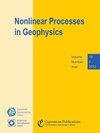Improving ensemble data assimilation through Probit-space Ensemble Size Expansion for Gaussian Copulas (PESE-GC)
IF 2.4
4区 地球科学
Q3 GEOSCIENCES, MULTIDISCIPLINARY
引用次数: 0
Abstract
Abstract. Small forecast ensemble sizes (< 100) are common in the ensemble data assimilation (EnsDA) component of geophysical forecast systems, thus limiting the error-constraining power of EnsDA. This study proposes an efficient and embarrassingly parallel method to generate additional ensemble members: the Probit-space Ensemble Size Expansion for Gaussian Copulas (PESE-GC; “peace gee see”). Such members are called “virtual members”. PESE-GC utilizes the users' knowledge of the marginal distributions of forecast model variables. Virtual members can be generated from any (potentially non-Gaussian) multivariate forecast distribution that has a Gaussian copula. PESE-GC's impact on EnsDA is evaluated using the 40-variable Lorenz 1996 model, several EnsDA algorithms, several observation operators, a range of EnsDA cycling intervals, and a range of forecast ensemble sizes. Significant improvements to EnsDA (p<0.01) are observed when either (1) the forecast ensemble size is small (≤20 members), (2) the user selects marginal distributions that improve the forecast model variable statistics, and/or (3) the rank histogram filter is used with non-parametric priors in high-forecast-spread situations. These results motivate development and testing of PESE-GC for EnsDA with high-order geophysical models.通过高斯协方差的 Probit 空间集合规模扩展(PESE-GC)改进集合数据同化
摘要在地球物理预报系统的集合数据同化(EnsDA)组件中,小规模预报集合(小于 100 个)很常见,从而限制了 EnsDA 的误差约束能力。本研究提出了一种高效且令人尴尬的并行方法来生成额外的集合成员:高斯协方差的 Probit 空间集合规模扩展(PESE-GC;"和气生财")。这些成员被称为 "虚拟成员"。PESE-GC 利用用户对预测模型变量边际分布的知识。虚拟成员可以从任何具有高斯共轭分布的(潜在非高斯)多元预测分布中生成。PESE-GC 对 EnsDA 的影响使用 40 变量 Lorenz 1996 模型、几种 EnsDA 算法、几种观测运算符、一系列 EnsDA 循环区间和一系列预测集合大小进行评估。在以下情况下,EnsDA 有明显改善(p<0.01):(1)预报集合规模较小(≤20 个成员);(2)用户选择的边际分布改善了预报模型变量统计;和/或(3)在高预报散布情况下使用非参数先验的秩直方图滤波器。这些结果推动了针对高阶地球物理模型 EnsDA 的 PESE-GC 的开发和测试。
本文章由计算机程序翻译,如有差异,请以英文原文为准。
求助全文
约1分钟内获得全文
求助全文
来源期刊

Nonlinear Processes in Geophysics
地学-地球化学与地球物理
CiteScore
4.00
自引率
0.00%
发文量
21
审稿时长
6-12 weeks
期刊介绍:
Nonlinear Processes in Geophysics (NPG) is an international, inter-/trans-disciplinary, non-profit journal devoted to breaking the deadlocks often faced by standard approaches in Earth and space sciences. It therefore solicits disruptive and innovative concepts and methodologies, as well as original applications of these to address the ubiquitous complexity in geoscience systems, and in interacting social and biological systems. Such systems are nonlinear, with responses strongly non-proportional to perturbations, and show an associated extreme variability across scales.
 求助内容:
求助内容: 应助结果提醒方式:
应助结果提醒方式:


